What is a Ball Bearing?
The Function of Ball Bearings
From small and large motors, to car axles to electric fans and hard disc drives (HDDs), ball bearings are used in a wide array of machines for rotary motion. Ball bearings support rotary parts and reduce friction to facilitate the smooth operation of machines. The size of ball bearings can range from smaller than a grain of rice – small enough to fit inside a wristwatch, or a US coin—to over one meter in diameter for factory and power plant applications. NMB, a Minebea Group Company, specializes in the manufacture of miniature and small-sized ball bearings with an outer diameter of 30mm or less.
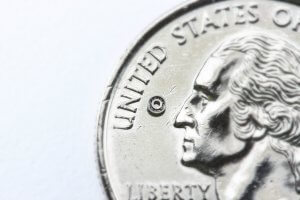
NMB Miniature Ball Bearing on US Coin
Ball Bearing Components
Ball bearings are comprised of four major parts: a large ring (outer ring), a small ring (inner ring), balls between the rings (steel balls), and a cage to prevent the balls from hitting each other. The modern structure dates back to around 1500, when Leonardo da Vinci invented ball bearings to reduce friction against the axles of horse drawn carts. For more than 500 years, the ball bearing has been defined by this simple structure.
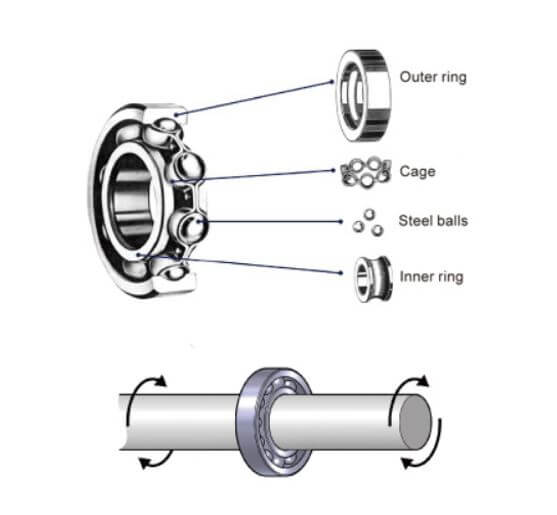
Ball Bearing Components
The Precision of a Ball Bearing
The main function of a ball bearing is to reduce friction and facilitate smooth rotation of an axis. Modern ball bearings test the very limits of precision. As an example, one of the key elements to making an ultra-precise ball bearing is the degree to which the groove where the balls roll can be made into a perfect circle.
The most important performance measure in judging a ball bearing is the extent to which it reduces friction and facilitates smooth and easy rotation. Ball bearings may end up in aircraft, automobiles, precision medical equipment and many other end products, but no matter the application, it is important to maintain smoothness and minimize friction. Changes in the times bring diversification and complexity in end products and machine types along with new performance requirements for ball bearings, including miniaturization, higher rotation speeds, durability, and duration, as well as noise reduction.
Miniature Ball Bearing Manufacturing
While the basic structure of a ball bearing is very simple, the improvement of said ball bearing requires enhancing the manufacturing precision of the ball bearing components to their limit. In order to maintain complete control of the manufacturing process, NMB manufactures all bearing components in-house. To assist and contain the precision required in a ball bearing, we have developed in-house grinding machines that can be controlled to sub-micrometer precision (one ten-thousandth of a millimeter). Polishing and automated assembly equipment is also developed and maintained in-house.
Ball Bearing Materials
Chrome steel is used for standard ball bearing applications and environments where corrosion resistance is not a factor. DD™ Material is a 400 series Martensitic stainless steel combined with a heat-treating process exclusively developed by NMB’s parent company, Minebea. Miniature and instrument bearings manufactured from DD™ Martensitic stainless steel meet the performance specifications of bearings that are manufactured with AISI 440C Martensitic stainless steel, and it is equal to or superior in hardness, superior in low noise characteristics, and is equivalent in corrosion resistance. These material characteristic advantages make for lower torque, smoother running, and long-life bearings.
Manufacturing Process

Cutting is the first step of the manufacturing process. Drills and cutting tool machines are used to shape and cut the raw material into rings.
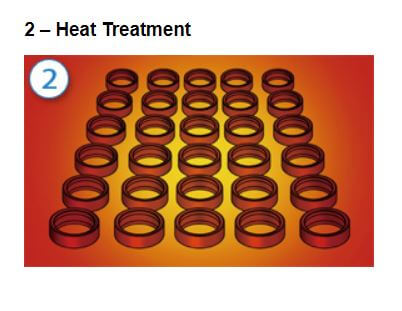
A heat treatment process is used to enhance the durability and increase the life of the cut metal piece.
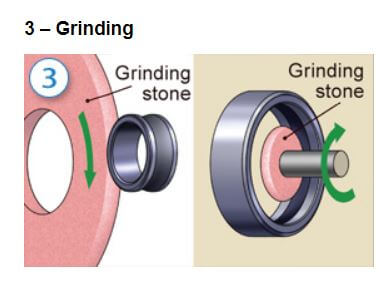
A grinding stone is used to grind the surfaces of parts to the required dimensional accuracy and precision. Dimensions such as the outer and inner diameters and the width are ground to micrometer (one-thousandth of a millimeter) precision, as is the groove, a key internal structure formed between the inner and outer rings in which balls run.

The groove between the outer and inner rings in which the balls run is honed to nanometer (one-thousandth of a micrometer) precision.
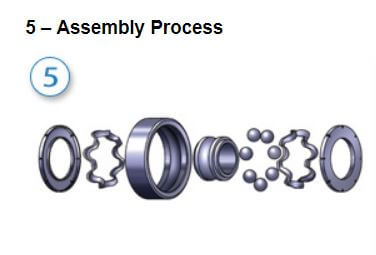
The inner and outer rings, balls and cage; also known as a retainer, are assembled. Lubrication such as oil or grease is applied based on the application requirement of the bearing. After lubrication has been applied and based on the customer’s requirements, the bearing is assembled with either one or two shields. This is the process where exactly the right parts are assembled to meet the customer’s specific requirements.
Uniform Manufacturing Processes around the World
The manufacturing process for miniature ball bearings requires extremely delicate and sophisticated precision, and simply using the same materials and manufacturing equipment does not guarantee that uniform products will be produced. MinebeaMitsumi has introduced a proprietary “warp and weft” approach to ensure that all of its eight manufacturing plants worldwide produce a uniform quality of products.
Vertical examination of all the manufacturing processes is the “warp”. Plant managers examine all the manufacturing processes and machines in every facility to ensure that the basis of MinebeaMitsumi’s long-accumulated knowledge is integrated and verified.
The “weft” in this system is the dispatch of managers for each of the manufacturing processes from the Karuizawa Plant, the “mother plant,” to the seven overseas plants to ensure with an objective eye that processes are horizontally deployed throughout the world.
One of the features of this system is the frequent visits by the Karuizawa Plant managers to the overseas plants, much as if they were visiting a plant next door, to oversee and train local employees. The combination of this warp and weft enables MinebeaMitsumi to achieve a manufacturing system that guarantees uniform products and high productivity, no matter where they were manufactured.
Dedication and commitment to the continuous improvement of manufacturing processes require a significant investment of corporate resources in a wide range of technical disciplines. It also requires the implementation of these advanced technologies, and their application, to every phase of parts processing, bearing assembly and inspection.
Our ability to turn out millions of bearings of the highest quality at competitive costs every month has helped to make the company the world’s leading manufacturer of miniature and instrument ball bearings.
How do bearings work
At a core level, a bearing reduces friction in machines and applications by allowing for balls to roll across a surface, as opposed to an object sliding over a surface (which would create more friction).
Bearings reduce friction by allowing smooth metal balls to roll against a metal surface, “bearing” the radial or thrust load of the device and allowing for a smooth spinning motion or whatever other application is necessary for the product, part or machine. Ball bearings (using smooth balls) are the most common type but there are also roller bearings and tapered bearings.
What is a ball bearing
Ball bearings are a specific type of bearing that uses smooth balls to reduce friction between two spinning or contacting surfaces, such as the spinning parts of a machine or other electric motor device.
Bearings in general can use rollers, balls or other items to reduce friction created by sliding or moving parts that come into contact with each other and cause wear and tear and eventually damage and total failure. Ball bearings are the easiest to make in general and the most common in most machines and applications from household products like a fan, to complex industrial machinery.

